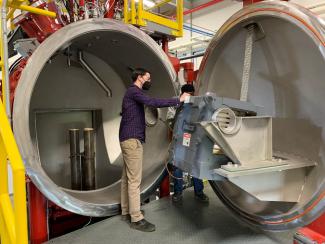Five thousand years ago, someone discovered that by melting copper and combining it with a small amount of similarly melted tin, they could create bronze, a stronger metal used for weapons, pots and tools. It became known as the first metal alloy and ushered in the “Bronze Age.”
In the 21st Century, NETL is at the forefront of efforts to create the strongest, most innovative metal alloys possible. Those alloys are needed because new cutting-edge energy-producing processes and facilities that can generate affordable, clean electricity and support growth in emerging U.S. industries require cost-effective, durable alloys used in construction.
NETL’s advanced alloy development capabilities in Albany, Oregon, are helping to formulate unique alloys that can perform in extreme environments that range from the vacuum of space to the crushing pressures of the deep ocean. Advanced alloys are essential to achieve net-zero carbon emissions in the power sector by 2035 and the broader economy by 2050 ── key goals of the Administration to address climate change.
The alloy needs of the energy industry are evolving because of the diversification of power generation. For example, greater use of renewable, intermittent sources are resulting in plants being subjected to cyclic operating conditions that bring on changes in temperatures and pressures. This “on-off” operation mode can cause metal-fatigue of components which increases materials performance requirements. Additionally, the safe production, transportation, and storage of hydrogen requires alloys that can withstand becoming brittle when exposed to hydrogen.
Alloying is critical to increase strength and corrosion resistance of pure metals. Alloys are generally made by melting two or more metals together. The metals are mixed in the melt. Upon cooling and solidification, the resulting solid material is an alloy that is designed to resist corrosion and mechanical degradation when exposed to extreme environments.
NETL’s advanced alloy development capabilities are anchored by its extensive ingot metallurgy capabilities. These capabilities allow NETL to validate alloy solutions at scales that readily translate to industrial practice, which helps accelerate commercialization of alloy concepts.
Key melting equipment, at the Albany NETL site includes:
- Induction Melting and Vacuum Induction Melting (VIM) ── An induction furnace is an electrical furnace in which metal is melted through induction heating. The metal to be melted is contained in a nonconductive crucible, surrounded by a coil of copper wire. An alternating electrical current is passed through a water-cooled copper coil creating a magnetic field that couples with the metal inside the crucible, The magnetic field induces eddy currents in the metal and through the electrical resistance of the metal, the metal is heated. The melt process can be done in air or in vacuum. NETL’s VIM capabilities can produce ingots ranging from 15 to 500 pounds.
- Vacuum Arc Remelting (VAR) ── VAR is a secondary melting process for production of metal ingots, The VAR process is widely used to improve the cleanliness of standard air-melted and vacuum induction melted ingots. It is also used to produce alloys from highly reactive materials (such as titanium) that react with crucibles used in the VIM process. VAR is similar to welding processes; a VIM ingot is remelted by striking an electrical arc between the VIM ingot and the bottom of a water-cooled copper crucible. The VIM ingot is consumed during melting and re-solidifies in the copper crucible. NETL can produce up to 8-inch diameter VAR ingots.
- Electroslag remelting (ESR) –ESR is process of remelting and refining alloys used for mission-critical applications in aerospace, energy, defense, and other applications. ESR is similar to VAR, except a slag material is feed between the VIM ingot and the crucible. The molten metal droplets pass through the slag. Impurities in the metal, such as sulfur, react with and are trapped in slag. This results in refining and increasing the purity of the ESR ingot. NETL can produce up to 8-inch diameter ESR ingots.
The metal melting capabilities are just part of an array of NETL facilities that help evolve specialty metals and processes. The Lab’s alloy development approach leverages computational materials engineering, manufacturing at scale, and performance assessments to develop alloys for advanced technologies.
The work allows U.S. industry, government agencies (including other national laboratories) and research universities to validate and prototype alloy solutions that will accelerate the development of alloys needed to enable and deploy clean energy and other advanced technologies.
NETL is a U.S. Department of Energy national laboratory that drives innovation and delivers technological solutions for an environmentally sustainable and prosperous energy future. By leveraging its world-class talent and research facilities, NETL is ensuring affordable, abundant and reliable energy that drives a robust economy and national security, while developing technologies to manage carbon across the full life cycle, enabling environmental sustainability for all Americans.
Top: NETL’s 500lb Vacuum Induction Melting Reactor at its Albany, Oregon, site is the latest addition to the Laboratory’s array of metal melting abilities.




